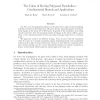Free Online Productivity Tools
i2Speak
i2Symbol
i2OCR
iTex2Img
iWeb2Print
iWeb2Shot
i2Type
iPdf2Split
iPdf2Merge
i2Bopomofo
i2Arabic
i2Style
i2Image
i2PDF
iLatex2Rtf
Sci2ools
COMGEO
1998
ACM
1998
ACM
The union of moving polygonal pseudodiscs - Combinatorial bounds and applications
Let P be a set of polygonal pseudodiscs in the plane with n edges in total translating with xed velocities in xed directions. We prove that the maximumnumber of combinatorial changes in the union of P is
n2
n
. In general, if the pseudodiscs move along curved trajectories, then the maximum number of changes in the union is
ns+2
n
, where s is the maximumnumber of times any triple of polygon edges meet in a common point. We apply this result in two di erent settings. First, we prove that the complexity of the free space of a constant-complexity polygon translating amidst convex polyhedral obstacles with n edges in total is O
n2
n
. Second, we show that the complexity of the space of lines missing a set of n convex homothetic polytopes of constant complexity in 3-space is O
n24
n
. Both bounds are almost tight in the worst case.
| Added | 21 Dec 2010 |
| Updated | 21 Dec 2010 |
| Type | Journal |
| Year | 1998 |
| Where | COMGEO |
| Authors | Mark de Berg, Hazel Everett, Leonidas J. Guibas |
Comments (0)

